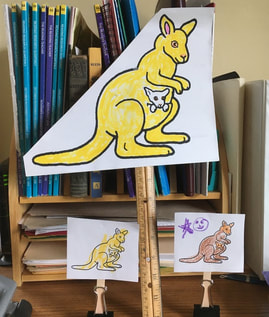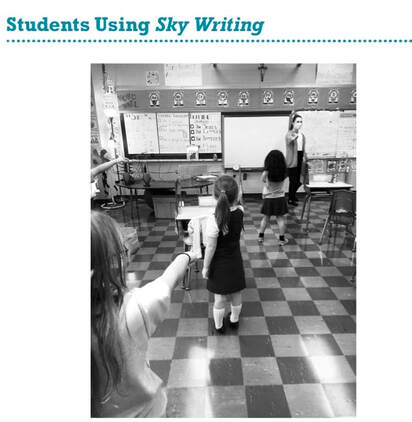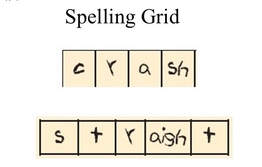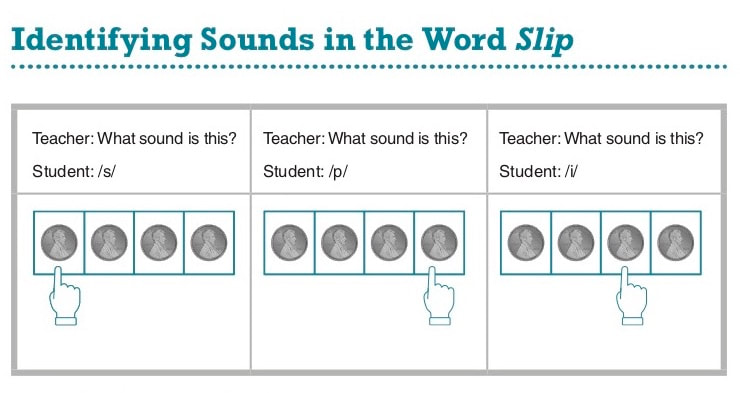|
Spoken language has sound, from the strings of utterances that we call sentences to the discrete, specific sounds (phonemes) that make up every word. It’s vital that young students become aware of the sounds of language and skillful in their analysis and manipulation, and so today’s post looks at phonology – the study (and teaching) of language sounds. Phonology and phonological awareness To begin, let’s be clear on terms. Phonological and phonemic are not synonymous. Rather, phonological is the more encompassing term. Think of it as a big bookshelf labeled “the general awareness of the sound structures of speech.” This bookshelf is divided into sections that include, moving from the largest sound units of speech to the smallest, whole words (sunset), syllables (sun and set), onsets and rimes (s-un and s-et), and phonemes (s-u-n-s-e-t). Students who are phonologically aware can hear and count the number of words in a spoken sentence, as well as the number of syllables in a word. They can also produce rhymes and alliterations, such as Henny Penny and Peter Piper, as well as segment words into their onsets and rimes, such as P-eter and P-iper. Phonemic awareness Phonemic awareness is a subset of phonological awareness; it occupies a small but very important space on the big bookshelf. Students with advanced phonological awareness are phonemically aware. This means they not only understands that words are an amalgamation of discrete sounds, but they can also hear individual sounds within any given word, segment these sounds from a whole word, blend them together to create a spoken word, and even create a new word by manipulating, subtracting, or adding sounds. Some languages are made up of over 100 discrete phonemes. Others, like Hawaiian, have fewer than 15. The English language has 44. To discriminate between these sounds, produce them, and manipulate them, a student doesn’t need to see anything at all and so phonological and phonemic activities can be done in in the dark. In a purely phonological activity, no text is involved. But skillful teaching is! Activities that move students down the bookshelf There are many activities for teaching phonology, from the word level to the discrete sound level (phonemes). To move students along the shelf, let’s start with two that draw attention to the macro levels of spoken language: understanding that sentences contain words and understanding words have syllables. In the next biweekly post, we’ll move to the micro level: words are made of discrete sounds called phonemes. Word level: Hoppy Kangaroo Hoppy Kangaroo helps students in preK and early kindergarten hear and count the number of words in a sentence. Hoppy jumps each time a word is said. If a sentence has four words – The cake is tasty – Hoppy jumps four times. Notice we are not talking about syllables (tasty has two). Rather, the emphasis is on recognizing words, the largest blobs of sounds in language. If you happen to have a kangaroo hand puppet, great. But my Hoppy is a simple piece of clip-art, colored and attached to a ruler. Student kangaroos are the same art, scaled smaller and taped to popsicle sticks. To teach, directly and explicitly tell students that sentences are made of words. Then introduce Hoppy however you like. Say Hoppy only jumps when whole words are spoken. Next, say a sentence, such as “I like grapes.” I think it’s best to start with sentences that have only single-syllable words. Have students say the sentence with you and maybe even on their own (I Say, We Say, You Say). As you hold Hoppy, repeat the sentence once more and this time make her hop each time a word is said: “I (hop) like (hop) grapes.” Finally, repeat the sentence once more and have your students count the number of time Hoppy hops. Click here to see a vid of Hoppy in action. Take the activity to a more advanced level by saying sentences with more words, first four and then five. Bring in some two-syllable words but remember: Hoppy hops on words, not syllables. For preschool and early kindergarten children, six to seven words might be a lot to count but see how far you can go. An even more advanced form of Hoppy Kangaroo is to put him out to pasture. Tell the kids that Hoppy is away, perhaps having breakfast at the IHOP (know you’re acronyms!). Then say a sentence at a slow to medium tempo and allow students to count the words without the kangaroo. To connect this activity to text without having to use spelled out words, use the Magic Line. I'll give more on the Magic Line in an upcoming post. Syllable level: Hands Together, Apart, and Away Advanced phonemic skills include adding, subtracting, and substituting phonemes to make new words out of existing words. Set the stage for this skill by teaching children to add and subtract the larger sound chunks of syllables. Deleting one word of a compound word eases them into this concept; replacing the deleted word with a different word, thus forming a new compound word, takes the skill to the next level. To help children better understand how deletions and additions work, use the hands together, apart, and away activity. To model this multi-sensory activity, turn your back to your students and present the back of your hands to preserve “reading left to right.” With your hands together, thumb touching thumb, say, “Daylight.” Pull your hands apart and say the compound words as separate words: “Day, light.” Next, put your hands back together and say, “Daylight.” Then, ask your students to say daylight without day. Model taking away your left hand and gently shaking your right. If they don’t know the remaining word, say, “Light.” Next, as your students to say daylight without light, taking away your right hand and gently shaking your left. If they don’t know the word, say, “Day.” The pictures from my recently published book show a first grader doing the activity. Click this link to see a video of me demonstrating Hands Together, Apart and Away. As with Hoppy Kangaroo, a more advanced form of Hands Together, Apart, and Away is to do the activity without using hands! Once kids can accomplish this with a 2-syllable compound word, go to three syllable words. At this point, unless you are an octopus, you simply cannot use your hands to segment syllables. Have students say a three-syllable word like December. Then ask them to say the word with a syllable deleted. For example, “Say December without the De.” (Cember) Or say, “Say December without the last syllable.” (Decem).” Or ask them, “What is the first syllable? What is the last syllable?”
In two weeks, phonemes! In my next blog I’ll describe Stretch, Tap, and Zap, which move children farther down the bookshelf by teaching them to hear and then segment the phonemes that make up words. BTW The activities described in this blog (as well as many others) can be found in my new book, How To Prevent Reading Difficulties, PreK-3: Proactive Practices for Teaching Young Children to Read. Click these links to the preview the book at Corwin or Amazon. Letter Confusion and Reversals: Why do they occur and how can we help students overcome them?4/5/2021
I had a big “ah hah!” moment when I recently reread Stanilas Dehaene’s book Reading and the Brain: The New Science of How We Read. In a chapter titled Reading and Symmetry, Dehaene, a French scientist who researches the neural basis of reading (among other things), explains why students often confuse letters such as b / d or d / p and sometimes read and spell words in reverse. It seems printing letters and words in reverse and reading certain words seemingly backwards typically has nothing to do with visual perception or visual memory. Rather, these things most often have everything to do with something called mirror generalization. Human brains Like all animal brains, human brains have evolved in relationship to their environment and physiology. Because we live with gravity, our brains can quickly realize that up is very different from down. Also, because our eyes are fixed in the front of our head, our brains know that ahead is very different than behind. But what about left and right? Consider these three objects, which are presented in Dahaene’s book. Do you recognize them instantly? Did you initially notice they were spatially backwards? In real life they appear this way: Mirror generalization Mirror generalization (sometimes called mirror invariance) arises from our body’s symmetrical nature and can be defined as the brain’s ability to recognize objects regardless of their spatial orientation. Imagine you are walking through a tropical forest and you come upon a bunch of monkeys. Some of the monkeys face you, some face away, some are on your left, others are on your right, and a few hang upside down from tree branches. Regardless of their spatial orientation, you instantly recognize all of them as monkeys. Why? Mirror generalization! Through this generalization, our brains automatically recognize an object regardless of how it is spatially presented. A natural function found in children as well as adults, mirror generalization saves us time and energy and helps us survive. In other words, your brain doesn’t care if a tiger, for example, is leaping at you from the left or the right. You brain’s only concern is to instantly recognize the thing as a tiger and then trigger a response in your body – RUN! The same effect holds true if the object is a city bus and you’re stepping out from the curb – STOP! When it comes to letters and words, however, an object rotated in space is not always the same thing. For example, consider this object - b. In the reading world, this object is the letter b and it represent the /b/ sound. Flip it and it becomes something different. Now it’s the letter d, representing the /d/ sound. Rotate it and it becomes something different again, the letter p. Mirror generalization is why many young children often confuse d / b and may read was as saw or spell stop as post. Simply put, they have not yet learned to suppress their brain’s tendency to register rotated letter forms and reversed letter sequences as the same object. Here’s a Dahaene quote from a section of Reading and the Brain. Specifically it’s about dyslexia but it references all students. The underlining is mine: “As a matter of fact, letter orientation does pose specific difficulties for large numbers of dyslexic children, who often confuse “b” with “d.” However, these are problems that are present in all children and not just dyslexics…Furthermore, mirror errors peak at between seven and ten years of age, when children learn to recognize letters, and then vanish.… Visual difficulties do not seem to play a dominant role in most of them.” (page 295). Unlearning is the new learning To learn that an object in one orientation is a b, another a d, and in a third a p, children must unlearn mirror generalization. But this process of suppression (or unlearning) does not happen naturally. How does it happen? Like the unnatural act of reading itself, most children unlearn their tendency to see a d as a b and was as saw through the efforts of teachers. Through teacher instruction, the brains of students are subtly rewired and mirror generalization, at least when it comes to letters and words, is suppressed or unlearned. In the end, emerging readers and spellers are able to at first intentionally discriminate and later automatically discriminate between mirror letters like p / d and words like stop/ post , was/saw, and net/ten. How can we helps students? When it comes to helping students turn off their mirror generalization for letters and words, there are a number of things we can do, especially for students who have brain wiring that is resistant to suppressing or unlearning the tendency. Here are some suggestions, many of which are described and explained in my new Corwin book, How to Prevent Reading Difficulties, PreK-3: Proactive Practices for Teaching Young Children to Read. You can also find video examples of many of them on my YouTube Channel: https://bit.ly/MWLit_YT_Channel
A Final Thought Here’s why I used the words typically and most often in my opening paragraph. Earlier I gave this Dahaene quote, “…Visual difficulties do not seem to play a dominant role in most of them.” But Dahaene goes on to say this about some students identified as having dyslexia: “In a few rare cases, however, left-right confusion does seem to be the true cause of dyslexia.” (page 295). It seems one can’t completely rule out left-right confusion and mirror generalization as the root cause of dyslexic behavior in a very low number of students. If you are teacher who works with a student who is not responding to intense, frequent, and long-term reading interventions (such as Orton-Gillingham, LiPPS, or Barton), a team meeting and possibly more assessment are in order. Sources/Citations
|
Mark WeaklandI am a teacher, literacy consultant, author, musician, nature lover, and life long learner.
|









 RSS Feed
RSS Feed